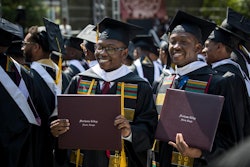In order to get rid of the stereotypes that follow disadvantaged minorities who are admitted to college through race-conscious affirmative action, admissions policies would have to hold the disadvantaged group to higher standards than their more advantaged peers.
So argue a pair of University of California, Berkley law professors in a new National Bureau of Economic Research paper titled “Affirmative Action and Stereotypes in Higher Education Admissions.”
The professors — Prasad Krishnamurthy and Aaron S. Edlin — concede “such a perverse double standard is clearly unacceptable.”
However, the purpose of the paper is not to call for the actual implementation of such a double standard, but rather to probe the degree to which admissions policies should be tailored to achieve what the professors describe as the elusive balance between equal representation and the curtailment of stereotypes.
“If stereotyping is a concern, the appropriate question to ask is not whether it can be eliminated, but how much an admission policy should target stereotypes relative to pursuing other goals,” the paper states.
In a paper laden with complex statistical formulas, the professors claim to show that when stereotypes are a result of social disadvantage, “they can persist even if schools adopt group-blind admissions.”
“Eliminating stereotypes requires a school to adopt higher admissions standards for students from disadvantaged groups in such cases,” the paper states.
To build their case, Krishnamurthy and Edlin rely on a representative sample of ACT scores from students who self identify as Black and White, and a scenario in which a school that admits the top 60 percent of students on the ACT would find itself with a lower percentage of Blacks than Whites due to variances in the two groups’ relative performance on the ACT, with Whites tending to score higher.
“Affirmative action policies may leave in place negative stereotypes, but ending affirmative action would not eliminate these stereotypes,” the paper states. “Therefore, critics of affirmative action who emphasize the harm of such stereotypes should be also be concerned with their effects under group-blind admissions.”
The professors concede that holding disadvantaged minorities to higher standards would reduce the representation of disadvantaged students to an even greater extent than a group-blind policy — and dramatically so.
To show the effect, the law professors present two scenarios — one where all students are required to score 20 or better on the ACT.
Under such a race-blind policy, the paper states, Black students would make up only 5.3 percent of admitted students, while white students would comprise the remaining 94.6 percent.
However, if Black students — for the purpose of reducing negative stereotypes — were required to score above a 22 on the ACT to gain admission and whites were permitted to continue to be admitted at a score of 20 or better, the percentage of Black students admitted would drop to 2.8 percent — or a 54 percent reduction in their representation under the race-blind policy.
“If admission policies sought to eliminate group stereotypes, it would have dramatic consequences for students from disadvantaged groups,” the paper states.
Which is one reason the double standard would not stand well on its own, the paper states.
Since there is a “tension” between a commitment to equal treatment and concern over negative stereotypes, the professors argue, a third value must enter the equation — the desire for equal representation or diversity.
“If a school is willing to consider tradeoffs between equal treatment and stereotypes, it requires a third goal such as equal representation to justify group-blind admissions,” the paper states.
It cautions, though that, that group-blind admissions are optimal “only when the conflicting goals of equal representation and limiting stereotypes exactly balance.”
“In our view, this knife edge case is an implausible justification for group-blind admission,” the professors ague. “It would again imply a desire on the part of some schools to have higher standards for disadvantaged students, a possibility which seems unlikely.
“Consequently,” the paper concludes, “some amount of affirmative action is almost always optimal if a school values all three of these goals.


















